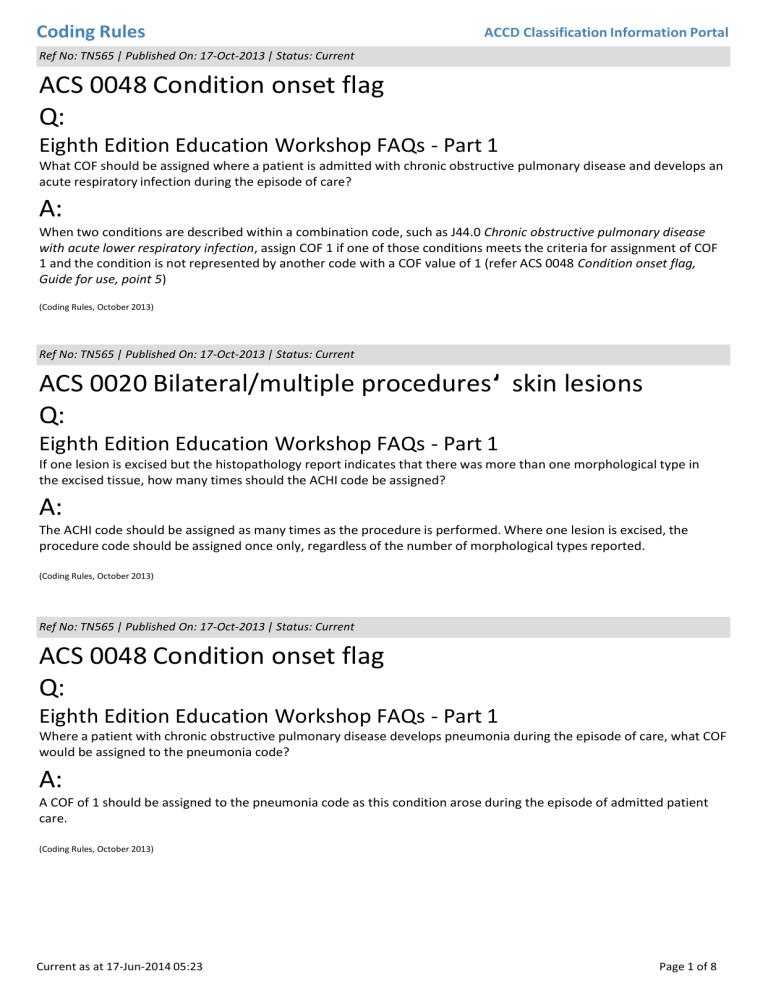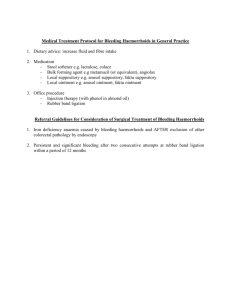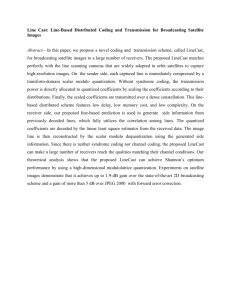Eighth Edition Education Workshop FAQs – Part 1

Coding Rules
Ref No: TN565 | Published On: 17-Oct-2013 | Status: Current
ACCD Classification Information Portal
ACS 0048 Condition onset flag
Q:
Eighth Edition Education Workshop FAQs - Part 1
What COF should be assigned where a patient is admitted with chronic obstructive pulmonary disease and develops an acute respiratory infection during the episode of care?
A:
When two conditions are described within a combination code, such as J44.0 Chronic obstructive pulmonary disease
with acute lower respiratory infection, assign COF 1 if one of those conditions meets the criteria for assignment of COF
1 and the condition is not represented by another code with a COF value of 1 (refer ACS 0048 Condition onset flag,
Guide for use, point 5)
(Coding Rules, October 2013)
Ref No: TN565 | Published On: 17-Oct-2013 | Status: Current
ACS 0020 Bilateral/multiple proceduresʹ skin lesions
Q:
Eighth Edition Education Workshop FAQs - Part 1
If one lesion is excised but the histopathology report indicates that there was more than one morphological type in the excised tissue, how many times should the ACHI code be assigned?
A:
The ACHI code should be assigned as many times as the procedure is performed. Where one lesion is excised, the procedure code should be assigned once only, regardless of the number of morphological types reported.
(Coding Rules, October 2013)
Ref No: TN565 | Published On: 17-Oct-2013 | Status: Current
ACS 0048 Condition onset flag
Q:
Eighth Edition Education Workshop FAQs - Part 1
Where a patient with chronic obstructive pulmonary disease develops pneumonia during the episode of care, what COF would be assigned to the pneumonia code?
A:
A COF of 1 should be assigned to the pneumonia code as this condition arose during the episode of admitted patient care.
(Coding Rules, October 2013)
Current as at 17-Jun-2014 05:23 Page 1 of 8
Coding Rules
Ref No: TN565 | Published On: 17-Oct-2013 | Status: Current
ACCD Classification Information Portal
ACS 0402 Cystic fibrosis - nasal polyps
Q:
Eighth Edition Education Workshop FAQs - Part 1
When nasal polyps or pancreatic insufficiency are documented as manifestations of cystic fibrosis (CF), which E84.- Cystic
fibrosis code should be assigned?
A:
The current structure of the CF codes in ICD-10, the parent classification of ICD-10-AM, is limited. It is not clear which
E84.- code should be assigned to reflect CF with nasal polyps or pancreatic insufficiency. Options to improve the classification of CF are being proposed internationally where these two manifestations are classified as otorhinolaryngological and exocrine pancreatic manifestations of CF respectively. As these options are currently not available in ICD-10-AM these manifestations should both be assigned to E84.8 Cystic fibrosis with other manifestations.
It is inappropriate to assign E84.0 Cystic fibrosis with pulmonary manifestations or E84.1 Cystic fibrosis with intestinal
manifestations for these manifestations (see also revised Q&A for Cystic fibrosis published June 2013).
(Coding Rules, October 2013)
Ref No: TN565 | Published On: 17-Oct-2013 | Status: Current
ACS 2114 Prophylactic surgery
Q:
Eighth Edition Education Workshop FAQs - Part 1
Patients who have neoplastic bone disease sometimes have a nail inserted into the diseased bone to assist in the prevention of fractures. As the clinicians refer to this as prophylactic surgery should a code from Z40.- Prophylactic surgery be assigned?
A:
ACS 2114 Prophylactic surgery principally provides instruction for assigning ICD-10-AM codes where prophylactic surgery is performed on healthy organs in patients who have known risks for the development of malignant disease.
The standard does not currently provide specific guidelines for the assignment of an additional diagnosis of Z40.-, for other types of prophylactic surgery. However, consideration will be given to expanding this standard in the future to address other scenarios where surgery is considered prophylactic.
Therefore, for this scenario assign the neoplastic bone disease as the principal diagnosis and a code from Z40.- is not currently required.
(Coding Rules, October 2013)
Current as at 17-Jun-2014 05:23 Page 2 of 8
Coding Rules
Ref No: TN565 | Published On: 17-Oct-2013 | Status: Current
ACCD Classification Information Portal
Haemorrhoids
Q:
Eighth Edition Education Workshop FAQs - Part 1
If haemorrhoids are documented as either ͚internal ͛ or ͚external ͛ do they still have to be assigned a code for unspecified?
A:
The classification of haemorrhoids is by degree. If the degree is not specified, the correct code to assign is K64.9
Haemorrhoids, unspecified following the index entry:
Haemorrhoids (bleeding) (external) (internal) (without mention of degree) K64.9
The terms ͚internal ͛ and ͚external ͛ are nonessential modifiers that do not affect the code assignment.
(Coding Rules, October 2013)
Ref No: TN565 | Published On: 17-Oct-2013 | Status: Current
Hernia
Q:
Eighth Edition Education Workshop FAQs - Part 1
If there is a causal link documented between a previous surgical procedure and an incisional hernia, can external cause codes also be assigned?
A:
Where there is documentation of a specific surgical procedure that has caused an incisional hernia, assign Y83._ as an additional code and Y92.22 Health service area for the place of occurrence (refer ACS 2001 External cause code use and
sequencing and Coding Matters September 2005 Volume 12, Number 2, updated June 2013). See also ACS 1904
Procedural complications.
(Coding Rules, October 2013)
Ref No: TN565 | Published On: 17-Oct-2013 | Status: Current
High flow nasal cannula (HFNC)
Q:
Eighth Edition Education Workshop FAQs - Part 1
Can high flow nasal cannula be used for adults as well as neonates?
A:
Yes, as per the Q&A for High Flow Cannula published in December 2011.
(Coding Rules, October 2013)
Current as at 17-Jun-2014 05:23 Page 3 of 8
Coding Rules
Ref No: TN565 | Published On: 17-Oct-2013 | Status: Current
ACCD Classification Information Portal
Resistance to antimicrobial and antineoplastic drugs
Q:
Eighth Edition Education Workshop FAQs - Part 1
Where MRSA is documented by the clinician, can the information from the pathology report be used where it provides the information about whether the MRSA is multi resistant or methicillin resistant?
A:
The guidelines in ACS 0010 General abstraction guidelines, direct that diagnostic results should be used to add specificity to already documented conditions that meet the criteria for code assignment. As it is important to establish whether MRSA is referring to methicillin resistance as opposed to the less specific and less common usage ͚multi resistance͛ the diagnostic results should be referenced (see ACS 0112 Infection with drug resistant microorganisms).
(Coding Rules, October 2013)
Ref No: TN565 | Published On: 17-Oct-2013 | Status: Current
Jaundice:
Q:
Eighth Edition Education Workshop FAQs - Part 1
Where a neonate is readmitted for phototherapy, does the procedure code for phototherapy need to be assigned in addition to the ICD-10-AM code for jaundice?
A:
The code for phototherapy of the newborn, 90677-00 [1611] Other phototherapy, skin, should only be assigned where the phototherapy is sustained for >12 hours as per the specific instructions contained within ACS 1615 Specific
interventions for the sick neonate.
(Coding Rules, October 2013)
Ref No: TN565 | Published On: 17-Oct-2013 | Status: Current
Minimally invasive procedures proceeding to open procedures
Q:
Eighth Edition Education Workshop FAQs - Part 1
If a patient has a diagnostic laparoscopy performed and then proceeds to have an open procedure, should a code be assigned for the diagnostic laparoscopy?
A:
A code for the diagnostic laparoscopy should be assigned in addition to the open procedure code(s). It is only appropriate to assign 90343-01 Laparoscopic procedure proceeding to open procedure where the procedure was intended to be performed using a minimally invasive technique but then is converted to an open procedure due to a complication or other unplanned circumstance. These codes should not be used for diagnostic endoscopy/laparoscopy/arthroscopy.
(Coding Rules, October 2013)
Current as at 17-Jun-2014 05:23 Page 4 of 8
Coding Rules
Ref No: TN565 | Published On: 17-Oct-2013 | Status: Current
ACCD Classification Information Portal
Single event multilevel surgery (SEMLS) Q:
Eighth Edition Education Workshop FAQs - Part 1
Can the codes from block [1580] Single event multilevel surgery [SEMLS] be assigned where a child with cerebral palsy has the multiple procedures performed as in the Tabular List, however the clinician has not documented SEMLS?
A:
Single event multilevel surgery, or SEMLS, needs to be documented in order to assign the codes from block [1580]
Single event multilevel surgery [SEMLS]. If there is uncertainty as to whether it is SEMLS being performed then the clinical coder should clarify with the clinician.
(Coding Rules, October 2013)
Ref No: TN565 | Published On: 17-Oct-2013 | Status: Current
Procedure for McRoberts Manoeuvre
Q:
Eighth Edition Education Workshop FAQs - Part 1
In the workshop presentation there was an exercise scenario that included McRoberts manoeuvre, a type of assisted delivery, for which no procedure code was assigned. Should the ACHI code 90477-00 [1343] Other procedures to assist
delivery be assigned in addition to O83 Other assisted delivery?
A:
A national guideline to mandate the assignment of an ACHI code for McRoberts manoeuvre does not currently exist.
The assignment of an ACHI code for McRoberts manoeuvre is similar to a previous query about assigning an ACHI code for spontaneous vertex delivery, for which current advice directs that ͟the assignment of the procedure code is optional as directed by jurisdictional guidelines.͟
NCCH will consider this advice along with the requirement to assign intervention codes for both McRoberts manoeuvre and spontaneous vertex delivery in a future edition of ICD-10-AM and ACS. (refer Coding Q&A Oct 2010 McRoberts manoeuvre and Q&A Dec 2011 Intervention code for spontaneous vertex delivery).
(Coding Rules, October 2013)
Ref No: TN565 | Published On: 17-Oct-2013 | Status: Current
Imaging services
Q:
Eighth Edition Education Workshop FAQs - Part 1
In the workshop presentation there were some scenarios where codes were assigned for imaging services such as CT and MRI guidance, where they were performed in association with other procedures. Even though these were done under anaesthetic should they be coded?
A:
As per ACS 0042 Procedures normally not coded, codes from ACHI Chapter 20 Imaging services should only be coded in certain circumstances, such as where cerebral anaesthesia is required in order for the procedure to be performed. The scenarios in the recent Eighth Edition Education should not have assigned codes for CTs and MRIs.
(Coding Rules, October 2013)
Current as at 17-Jun-2014 05:23 Page 5 of 8
Coding Rules
Ref No: TN565 | Published On: 17-Oct-2013 | Status: Current
ACCD Classification Information Portal
ACS 0048 Condition onset flag
Q:
Eighth Edition Education Workshop FAQs - Part 1
Why can͛t a COF 1 be assigned to J44.1 Chronic obstructive pulmonary disease with acute exacerbation, unspecified where the acute exacerbation arises during the episode of care?
A:
A chronic disease that is present on admission and is exacerbated during the episode of care should be assigned a COF of 2 (refer ACS 0048 Condition onset flag, Permissible values).
(Coding Rules, October 2013)
Ref No: TN565 | Published On: 17-Oct-2013 | Status: Current
ACS 0402 Cystic fibrosis - tune up
Q:
Eighth Edition Education Workshop FAQs - Part 1
When a patient is admitted to hospital for several days for CF ͚tune up͕͛ what principal diagnosis code should be assigned?
A:
Patients with CF typically require several admissions to hospital to improve ;͚tune up͛Ϳ their health level. A CF ͚tune up͛ involves the provision of intravenous antibiotics and intensive chest physiotherapy in order to minimise the risk of recurrent lung infections or other worsening symptoms. During the hospital stay, investigations such as lung function, x-ray or sputum culture may also be performed. A ͚tune up͛ is considered an integral part of the management of patients with CF and therefore appropriate code(s) from E84.- should be assigned, as per ACS 0001 Principal diagnosis and ACS 0402 Cystic fibrosis.
(Coding Rules, October 2013)
Ref No: TN565 | Published On: 17-Oct-2013 | Status: Current
ACS 0020 Bilateral/multiple procedures ʹ skin lesions code title
Q:
Eighth Edition Education Workshop FAQs - Part 1
If the codes for excision of separate skin lesions are assigned as many times as they are performed during a visit to theatre, why is the plural still in the code title, as in lesions (s)?
A:
It is acknowledged that the presence of the plural in the ͚Excision of lesion(s) of skin and subcutaneous tissue͛ codes is misleading following the changes to ACS 0020 Bilateral/multiple procedures. It was not possible to update the code titles to remove the ͚s͛ for Eighth Edition due to time limits imposed by the production cycle. It will, however, be updated for the Ninth Edition of ACHI.
(Coding Rules, October 2013)
Current as at 17-Jun-2014 05:23 Page 6 of 8
Coding Rules
Ref No: TN565 | Published On: 17-Oct-2013 | Status: Current
ACCD Classification Information Portal
Haemorrhoids
Q:
Eighth Edition Education Workshop FAQs - Part 1
Where there is no degree specified for the haemorrhoids but the clinician has documented ͚retract spontaneously͕͛ can the haemorrhoids be assumed to be second degree, as in the inclusion term in the Tabular List at K64.1 Second degree
haemorrhoids?
A:
Following the coding process, the code for second degree haemorrhoids can be assigned in this case by following the index entry first:
Haemorrhoids
- 2nd degree (grade/stage II) (with prolapse but retracts spontaneously) then by reference to the inclusion term at K64.1 Second degree haemorrhoids in the Tabular List, where it specifies
͚Haemorrhoids that prolapse on straining but retract spontaneously.͛ (refer to Tabular List of Diseases, Guidance in the
use of ICD-10-AM).
(Coding Rules, October 2013)
Ref No: TN565 | Published On: 17-Oct-2013 | Status: Current
Haemorrhoids
Q:
Eighth Edition Education Workshop FAQs - Part 1
What code(s) should be assigned when multiple grades of haemorrhoids are documented or terminology such as grade
II-III haemorrhoids is used?
A:
While there is currently nothing in the classification to preclude the assignment of multiple codes to reflect different stages of haemorrhoids, clinical advice indicates that it is only necessary to assign one code for the most severe haemorrhoid grade.
Improvements to the classification will be considered in the future to reflect this advice.
(Coding Rules, October 2013)
Ref No: TN565 | Published On: 17-Oct-2013 | Status: Current
Haemorrhoids
Q:
Eighth Edition Education Workshop FAQs - Part 1
What haemorrhoid code should be assigned when a patient is admitted for banding of haemorrhoids?
A:
ACS 0942 Banding of haemorrhoids was deleted for Eighth Edition as the banding related to internal haemorrhoids, which is no longer relevant now that haemorrhoids are classified by degree. Therefore code assignment is determined by the clinical documentation .
(Coding Rules, October 2013)
Current as at 17-Jun-2014 05:23 Page 7 of 8
Coding Rules
Ref No: TN565 | Published On: 17-Oct-2013 | Status: Current
ACCD Classification Information Portal
Resistance to antimicrobial and antineoplastic drugs
Q:
Eighth Edition Education Workshop FAQs - Part 1
Can a code for resistance to antibiotics be assigned where the resistance is not documented by the clinician, however the information is in the pathology report and the antibiotic treatment is changed?
A:
The clinician must document the drug resistance in the record in order to assign a code from Z06.- Resistance to
antimicrobial drugs (see ACS 0112 Infection with drug resistant microorganisms).
(Coding Rules, October 2013)
Current as at 17-Jun-2014 05:23 Page 8 of 8





